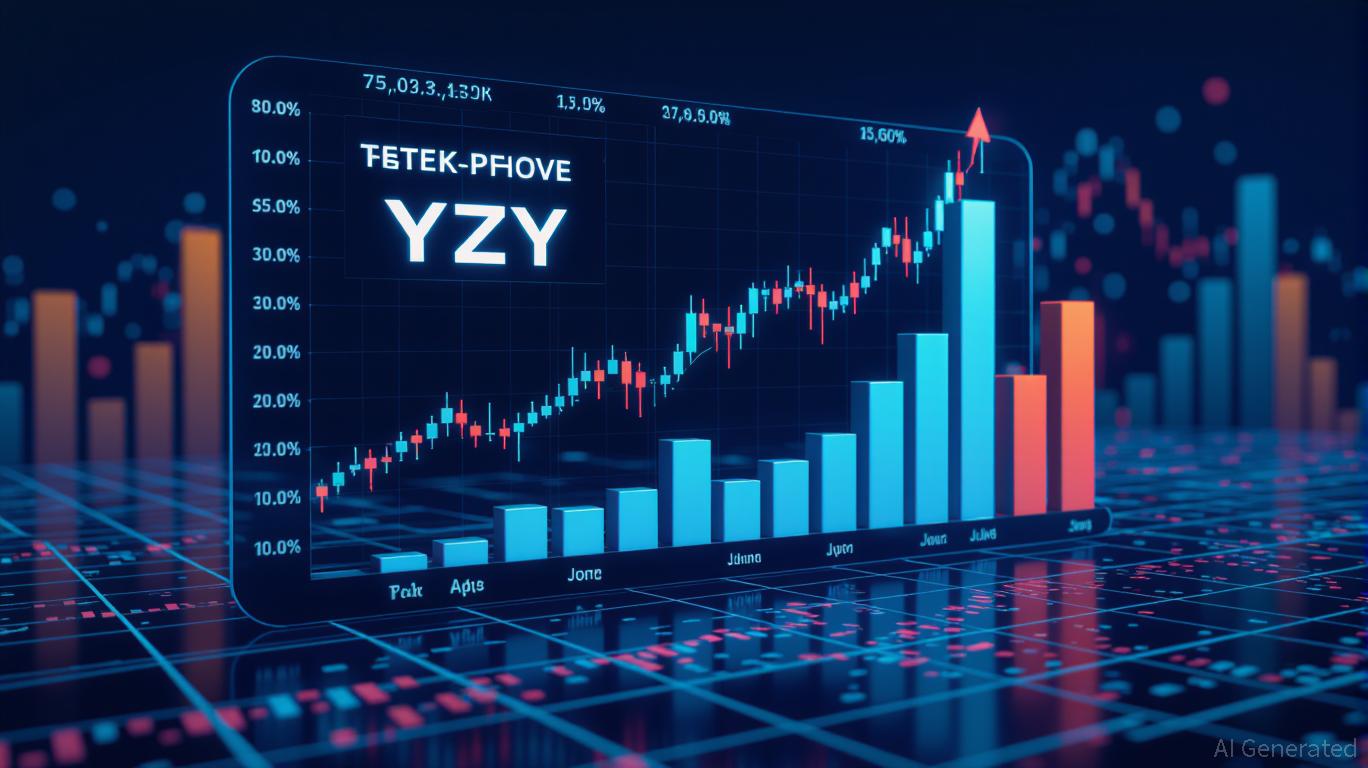Ethereum's Institutional Adoption and Treasury Dynamics: A $7,500+ Catalyst by 2025
- Ethereum dominates 2025 institutional treasuries via yield generation, regulatory clarity, and deflationary dynamics, outpacing Bitcoin's zero-yield model. - SEC's in-kind ETF approval boosted Ethereum liquidity, enabling 3-5% staking yields while Bitcoin ETFs face structural limitations in low-interest environments. - Institutional adoption accelerates as 19 public companies allocate 2.7M ETH for active yield, contrasting Bitcoin ETFs' $171M vs Ethereum ETFs' $1.83B inflows in August 2025. - Ethereum's
The institutional investment landscape in 2025 has undergone a seismic shift, with Ethereum emerging as a dominant force in treasury strategies. While Bitcoin remains a cornerstone of digital asset portfolios, Ethereum's structural advantages—yield generation, regulatory clarity, and programmable scarcity—are reshaping capital flows. For investors, understanding the mechanics of Ethereum's institutional adoption and its competitive edge over Bitcoin treasuries is critical to identifying the next phase of growth.
Regulatory Clarity and Staking: Ethereum's Institutional Edge
The U.S. Securities and Exchange Commission's (SEC) July 2025 approval of in-kind creation and redemption mechanisms for Ethereum ETFs marked a turning point. This innovation allowed institutional investors to exchange ETH directly for ETF shares, slashing transaction costs and enhancing liquidity. By contrast, Bitcoin ETFs, despite attracting $54 billion in inflows over 20 months, lack staking functionality, leaving them structurally disadvantaged in a low-interest-rate environment.
Ethereum's reclassification as a utility token under the CLARITY and GENIUS Acts further solidified its appeal. Staking yields of 3–5% now make ETH a yield-generating asset, a stark contrast to Bitcoin's zero-yield model. This has driven a surge in corporate treasury allocations, with 19 public companies now holding 2.7 million ETH for active yield generation. For context, , compared to Bitcoin ETFs' recent stagnation.
Deflationary Dynamics and Valuation Floors
Ethereum's treasury dynamics are underpinned by structural deflation. EIP-1559 burns, combined with staking, have created a 0.5% annual supply contraction. This contrasts with Bitcoin's fixed supply model, which lacks mechanisms to counter inflationary pressures from network growth. Meanwhile, Ethereum's technological upgrades—Pectra, Dencun, and EIP-4844—have reduced gas fees by 90%, making it a scalable platform for DeFi and enterprise applications.
The valuation floor for Ethereum is further reinforced by its utility. Unlike gold's physical scarcity or Bitcoin's passive store-of-value role, Ethereum's programmable scarcity allows it to generate value through smart contracts, staking, and DeFi protocols. This has attracted institutional capital seeking both capital appreciation and income. For example, reflects a strategic shift toward assets that combine scarcity with active yield generation.
Institutional Buying Momentum and Market Sentiment
On-chain metrics underscore Ethereum's institutional appeal. Mega whales (holders of 10,000+ ETH) increased their holdings by 9.31% since October 2024, while exchange-held ETH balances hit a nine-year low of 14.88 million tokens. This reduction in liquidity correlates historically with price appreciation, as large investors lock in long-term value.
Recent inflow data highlights the momentum gap: In the last five trading days of August 2025, Ethereum ETFs attracted $1.83 billion, dwarfing Bitcoin ETFs' $171 million. This trend is supported by macroeconomic tailwinds, including the Federal Reserve's dovish policy, which makes Ethereum's staking returns more attractive than traditional fixed-income assets.
Investment Implications and Strategic Allocation
For investors, Ethereum's institutional adoption presents a compelling case for allocation. Key opportunities include:
1. Staking Products: Direct ETH staking or institutional-grade staking derivatives offer 3–5% yields, outperforming Bitcoin's zero-yield model.
2. ETF Exposure: Ethereum ETFs like ETHA provide scalable, SEC-compliant access to institutional-grade yield generation.
3. Corporate Treasury Plays: Companies holding ETH for yield generation (e.g., through staking or DeFi) offer dual exposure to Ethereum's price and utility.
However, risks remain. Regulatory shifts, particularly the SEC's October 2025 rulings on staking integration and custody standards, could introduce volatility. Investors should monitor these developments while maintaining a diversified approach.
Conclusion: A $7,500+ Catalyst
Ethereum's institutional adoption is not merely speculative—it is a structural redefinition of capital allocation. With $27.66 billion in Ethereum ETF AUM, corporate treasuries actively deploying ETH, and deflationary mechanisms reinforcing its valuation floor, Ethereum is positioned to outperform Bitcoin in both yield and growth. As the SEC's October rulings loom, the path to $7,500+ by 2025 appears increasingly probable for investors who align with Ethereum's institutional-grade dynamics.
Disclaimer: The content of this article solely reflects the author's opinion and does not represent the platform in any capacity. This article is not intended to serve as a reference for making investment decisions.
You may also like
The Systemic Risks of Overleveraged Stablecoins: Lessons from the YZY Token Collapse
- Kanye West's YZY token collapsed 80% in days after a $3B Solana-based surge, exposing DeFi risks from celebrity-driven speculative tokens. - Centralized token allocation (70% to West's team) and liquidity pool flaws enabled insider profits while retail investors faced 10%+ slippage. - 3x leverage on platforms like Hyperliquid amplified losses, with one trader losing $704K as leveraged positions triggered cascading instability. - SEC's reactive enforcement and fragmented global crypto regulations (vs. EU'

Altcoin Opportunities Amid Cardano’s Potential Decline
- Cardano (ADA) faces bearish pressure near $0.87, with technical indicators signaling potential decline to $0.60 amid delayed upgrades and regulatory uncertainty. - Altcoin market consolidation (70% in top 10 projects) highlights undervalued opportunities in high-utility coins like MAXI, HYPER, LINK, and POL. - Contrarian strategies favor projects with real-world partnerships (e.g., Chainlink’s JPMorgan adoption) and scalable infrastructure over speculative narratives. - Macroeconomic risks, including Fed

K33’s Bitcoin Strategy and Regulatory Readiness Position the Company as a High-Growth Play in the Evolving Crypto Market
- K33 AB aligns with EU MiCA regulations through CASP licensing and TFR compliance, securing institutional trust in a fragmented crypto market. - The firm's Bitcoin treasury strategy, funded by SEK 85M share issuance, targets 1,000 BTC to leverage institutional demand for reserve assets. - Q2 2025 revenue doubled despite 25% market decline, driven by Bitcoin-backed services and partnerships like Goobit's custody infrastructure. - MiCA-ready infrastructure enables scalable revenue streams, including Smart L

Infrastructure-Driven Web3 Adoption in Asia: Unlocking Metaverse and Blockchain Opportunities
- Asian governments drive Web3 growth via regulatory reforms, including South Korea’s RWA tokenization sandbox and Japan’s tax incentives for blockchain gaming. - Enterprises like Sony and Kakao integrate blockchain into gaming and super apps, while metaverse platforms expand decentralized identity and cross-industry use cases. - Institutional investors fuel market maturation, with South Korea’s Kimchi Premium and Thailand’s G-Tokens unlocking new capital flows for Web3 infrastructure. - Key investment opp
